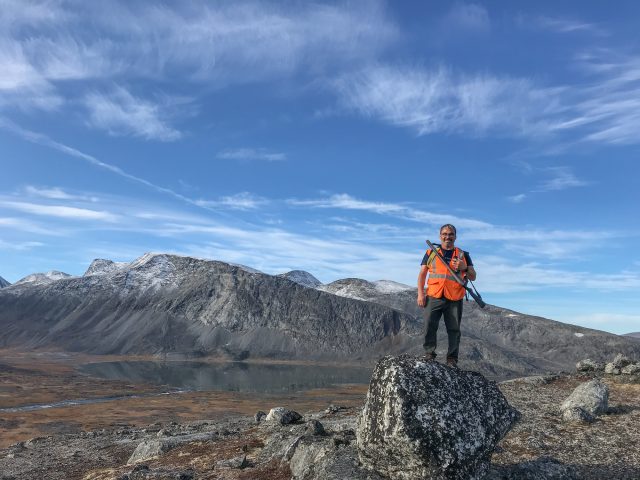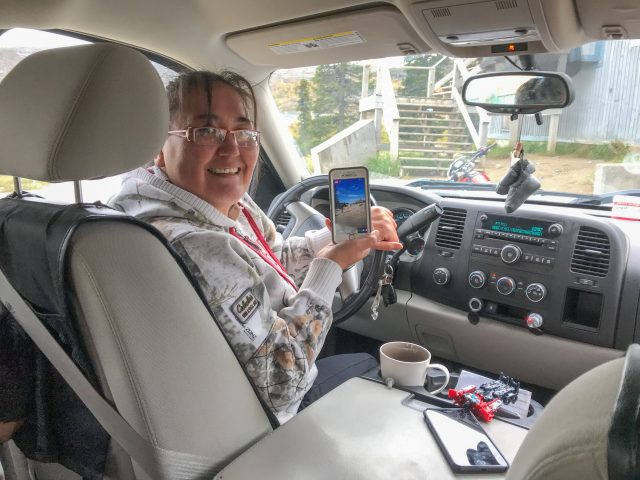Moravian missionaries arrived in Canada in the 1700s, forever altering the future of the country's Inuit population. Beginning in the 19th century, Inuit children were taken away from their families and forced to attend residential schools (boarding schools), where they were not allowed to speak their own language. In the 1950s, thousands of Inuit in Nunatsiavut (the easternmost of Canadas four Inuit regions) were forcibly removed from their land and stripped of their native language and customs. As a result, a generation of students that lost their culture gave birth to children who are now, themselves, searching for new ways to reclaim it.
Restoring that culture is a challenge, because many Inuit currently live in remote communities that lack roads and transportation infrastructure, leaving them isolated from each other. But technology has started helping them to connect with other Inuit across the country, to preserve traditional cultural practices, and to create a space for young people to learn about and participate in their heritage.
Of the 65,000 Inuit spread across Canada, about 7,200 are Labrador Inuit. About a third of these Labrador Inuit reside in Nunatsiavut, which has five major Inuit communities scattered along the coastline of Newfoundland Labrador province. None of the communities are connected to each other—or to anywhere else for that matter— by road, and they can only be reached by airplane or boat. Nain, with a population of approximately 1,200 people, is the largest and northernmost Inuit community.
But Nain has a key advantage in terms of integrating into the wider Inuit world: its the only one of these communities with mobile cellular service. Up until a year ago, web surfing and social media usage was largely confined to the home in Nain. In July 2019, however, mobile phone service arrived in Nain.
Some Inuit parents have the same concerns as parents in more connected regions, such as whether their children are spending too much time online. But some of those children are using the technology to connect with Inuit communities—and their traditions—that they might never experience otherwise.
Life before cell coverage
I arrived in Nain in September 2019 on an Adventure Canada expedition ship, just two months after cell service arrived in the city. We were the first (and only) expedition ship to visit the town of 1,100 people all year. After seven days of sailing and hiking without Internet access, the towns new cell service was a very welcome surprise to the mostly Canadian and American passengers on board. Many of those passengers immediately logged on to social media.
Even though cell phone coverage wasnt available until recently, some Nain residents had cell phones that they used to connect to the Internet using home Wi-Fi connections. But until 2019, they had no reason to take their phones with them outside the house unless they were traveling to another part of Canada that had service.
Many residents—the younger ones, especially—had learned to work around the limited access. Megan Dicker, a 20-year-old geography student from Nain, said of the new cellular plans, “It wasnt really that big of a change from before. We knew all the houses with Wi-Fi so wed just stop to connect along the route to wherever we were going.” Dicker firmly believes that the new cell phone service is a good thing, but she noted that it must be used “in moderation."

According to Bert Pomeroy, the Nunatsiavut Governments Director of Communications, Inuit communities have long struggled with not only access to cellular coverage, but to adequate Internet speeds. As recently as two years ago, bandwidth was so limited in Nain that even the local government employees had difficulty sending files among each other. “Someone trying to send time sheets or a PDF to the payroll department may have to wait a few minutes for it to go through," Pomeroy said. "It got even worse in the afternoon when kids got out of school and got on Xbox or Netflix.”
When cell service arrived, Nains new mobile phone plans included data usage limits, so there was a need to educate the community on how these plans worked. Until this time, the only experience most people had with the Internet was with the unlimited access they enjoyed on a home Wi-Fi connection.
To help their neighbors avoid overage charges, the local Nunatsiavut Government and some individual citizens took it upon themselves to inform the community. Local residents who understood the data plans began posting explanations on their personal Facebook feeds to help inform their friends and family. In other words, they were using technology to educate others about technology.
The social media debate
There are some obvious practical benefits to the expanded access. The Inuit-led Nunatsiavut regional government in Nain has also embraced social media, sharing posts about upcoming cultural commemorations and doctor visits. Optometrists and dentists only visit the community every month or two, so its crucial that residents know when they can make appointments. When COVID-19 hit Canada, the Nunatsiavut Government and local politicians used social media to share information about social distancing.
Though Facebook and social media had already been available on desktop computers, locals in Nain have noticed a significant increase in its use since mobile phone service arrived. Some parents and elders are upset to see their children and grandchildren whipping out their phones during community events. They lament that instead of engaging with their neighbors and participating in celebrations and sporting events, some youth now prefer to stare at their screens.
At least half a dozen community members I spoke with expressed concern with the increasing amount of time they and their neighbors now spend online. One woman said she enjoys browsing her family and friends Facebook pages for about 15 minutes, after which she begins feeling depressed. Several residents also expressed concern with “over sharing” and “inappropriate” Facebook posts—a symptom of social media culture that just about anyone with a Facebook account has witnessed firsthand.

Young people see the experience a bit differently. They are finding Inuit peers in other communities through mutual friends on social media. Teenagers search through their friends Instagram followers and Facebook friends to find other Inuit youth with similar interests. They follow each other online and then share cultural information with each other, sometimes by live streaming from community gatherings.
Wayne Broomfield, the assistant expedition leader on Adventure Canadas tours through Nunatsiavut, accepted the good aspects of social media but voiced a different worry. “A lot of young Inuit arent connecting with the land anymore because they can do it so much more easily online,” he said. “Its good that theyre learning more about their culture on social media, but you cant get the same connection online as you can from actually going out on the land.”
Social media as culture-sharing platform
While the land may be a central feature of Inuit culture that cant be replicated online, others aspects do translate. Belinda Webb, the Deputy Minister of the Nunatsiavut Government, says her team saw a noticeable increase in Facebook followers and post engagement when they introduced a “word of the day” program in Inuttitut (the Inuit language thats also sometimes spelled Inuktitut). Webb, a mother herself, is also concerned with the potential negative consequences of youth spending more time online, but she supports the live streaming of community events.
“The more we can share our cultural experiences with each other and the rest of the world, the better," she says.
Inuttitut-langauge Facebook pages serve as a not-judgmental zone where Inuit can ask translation-related questions without feeling embarrassed or being teased for misspellings or lack of understanding.
Youth and some parents I spoke with noted that the ability to access Internet at social gatherings was allowing them to connect and share important cultural moments with Inuit across Canada. While some young people may be “guilty” of mindlessly scrolling through their social media feeds at a community event, many are actually streaming the event so that Inuit who live hundreds or thousands of miles away can also participate. Given the remoteness of most Inuit communities, where lack of roads means that travel is costly and only possible via airplane or ship, the significance of this increased connection cannot be understated.

Krissy Holwell, a mother of three in Nain, kindly drove me to interview a non-profit social youth enterprise in town. She waited in the car while I conducted the interview, and when I hopped into the back seat, she was staring at her screen, cheering. She was watching a live stream of a cross-country competition in Happy Valley-Goose Bay—a three-hour flight from Nain. She had just watched her son cross the finish line.
Flights to Happy Valley-Goose Bay run about $1,000 Canadian dollars (~$750 USD), a prohibitive sum for most parents. During a family trip to Toronto the previous year, Holwell and her husband spent nearly $20,000 to bring their four children to watch a hockey tournament. Live streaming can never fully replace real-life experiences, but it can be an excellent option for the majority of Canadian Inuit that dont have the means or opportunity to travel.
Social media as an educational tool
Youth are not only using social media to connect with other Inuit people across Canada—theyre also using it to learn about Inuit traditions like throat singing and female tattoos.
Inuit women are known to have tattooed their bodies for generations, a practice that was virtually wiped out by colonization. The significance of some tattoos remains unclear, but many believe that vertical lines down a womans chin and markings on her forehead and cheeks may have indicated that a girl was ready for womanhood, or that a woman had borne children or lost her husband.
Chin tattoos are returning slowly, more so among Greenlandic Inuit women and Alaskan Inuit women; wrist and thigh tattoos are more common among Inuit women in Canada. Youth in small Inuit communities research tattoo designs and their meanings on Instagram, then fly to Ottawa, St. Johns, and Happy Valley-Goose Bay, where tattoo artists like Jessica Coffey apply the tattoos using the traditional poke method.
Moravian missionaries from Saxony, Germany, arrived in Labrador in 1752 and considered traditional Inuit drum dancing and throat singing to be un-Christian. They actively prohibited the practices, and some older Moravian Labrador Inuit still frown on these “heathen” activities. Young people, on the other hand, are taking drum dancing and throat singing classes in their communities and searching for related videos on YouTube. Lena Onalik, an archeologist in Newfoundland and a culturalist with Adventure Canada, learned throat singing from her grandmother but now looks to YouTube to learn new songs.

arstechnica
[contfnewc] [contfnewc]







